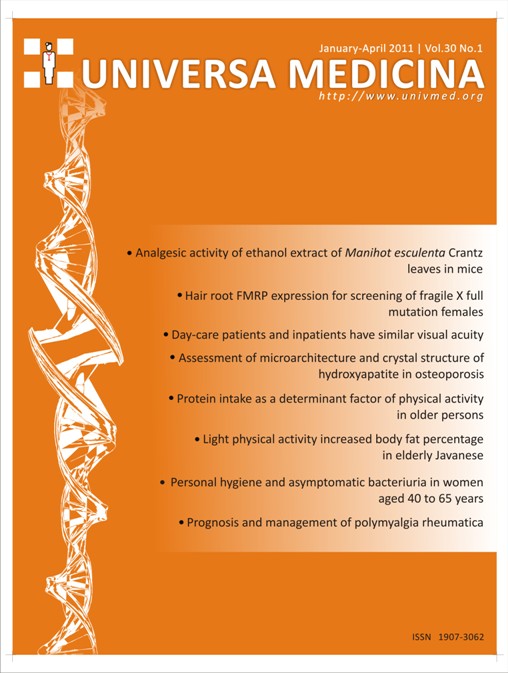Personal hygiene and asymptomatic bacteriuria in women aged 40 to 65 years
Main Article Content
Abstract
Article Details
Issue
Section
The journal allows the authors to hold the copyright without restrictions and allow the authors to retain publishing rights without restrictions.
How to Cite
References
Boekitwetan P, Suryawidjaja JE, Aidilfit M, Lesmana M. Multimicronutrient supplementation and asymptomatic urineary tract infections in the elderly. Univ Med 2009;28:25–33.
Raz R. Hormone replacement therapy or prophylaxis in postmenopausal women with recurrent urinary tract infection. J Infect Dis 2001;183 Suppl 1:S74-6
Dwyer PL, O’Reilly M. Recurrent urinary tract infection in the female. Curr Opin Obstet Gynecol 2001;14:537-43.
Curran EM, Hart-Van Tassel A, Judy BM, Nowicki B, Montgomery-Rice V, Estes M, et al. Estrogen increases menopausal host susceptibility to experimental ascending urinary-tract infection. J Infect Dis 2007;195:680-3.
Grady D. Management of menopausal symptoms. N Engl J Med 2006;355:2338-47.
Stamm WE. Estrogens and urinary tract-infection. J Infect Dis 2007;95:623-4.
Hu KK, Boyko EJ, Scholes D, Normand E, Chen CL, Grafton J, Fihn SD. Risk Factors for Urinary Tract Infections in Postmenopausal Women. 2004. Arch Intern Med 2004;64:989-93.
Stapleton A. Urinary tract infections in patients with diabetes. Am J Med 2002;113 Suppl 1A:S80-4.
Boyko EJ, Fihn SD, Scholes D, Chen CL, Normand EH, Yarbro P. Diabetes and the risk of acute urinary tract infection among postmenopausal women. Diabetes Care 2002;25:1778-83.
Bonadio M, Boldrini E, Forotti G, Matteucci E, Vigna A, Mori S, et al. Asymptomatic bacteriuria in women with diabetes: influence of metabolic control. Clin Infect Dis 2004;38:41-5.
Dalal S, Nicolle L, Marrs CF, Zhang L, Harding G, Foxman B. Long-term Escherichia coli asymptomatic bacteriuria among women with diabetes mellitus. Clin Infect Dis 2009;49:491-7.
Dawson B, Trapp RG, editors. Research questions about two separate or independent groups. In: Basic & clinical biostatistics. 4th ed. New York; Lange Medical Books/MCGRaw-Hill;2004.p. 134-61.
Nicolle LE. Asymptomatic bacteriuria: when to screen and when to treat. Infect Dis Clin North Am 2003;17:367-94.
Thomson RE Jr, Miller JM. Specimen collection, transport, and processing: bacteriology. In: Murray PR, Baron EJ, Jorgensen JH, Pfaller MA, Yolken RH, editors. Manual of Clinical Microbiology, 8th ed. Washington DC: American Society for Microbiology;2003.p.320-2.
Santos CAST, Fiaccone RL, Oliveira1 NF, Cunha S, Barreto ML, do Carmo BB, et al. Estimating adjusted prevalence ratio in clustered cross-sectional epidemiological data. BMC Med Res Method 2008;8:80 doi:10.1186/1471-2288-8-80.
Brown JS, Vittinghoff E, Kanaya AM, Agarwal SK, Hulley S, Foxman B. Urinary tract infections in postmenopausal women: effect of hormone therapy and risk factors. Obstet Gynecol 2001;98: 1045-52.
Dennerstein L, Dudley EC, Hopper Jl, Guthrie JR, Burger HG. A prospestive population-based study of menopausal symptoms. Obstet Gynecol 2000;96:351-8.
Jackson SL, Scholes D, Boyko EL, Abraham L, Fihn SSD. Predictors of urinary incontinence in prospective cohort of postmenopausal women. Obstet Gynecol 2006;108:855-62.
Stamm WE, Norrby SR. Urinary tract infections: disease panorama and challenges. J Infect Dis 2001;183 Suppl 1:S1-4.
Hooton TM. Pathogenesis of urinary tract infections: an update. J Antimicrob Chemother 2000;46 Suppl 1:S1-7.
Shortliffe LM, McCue JD. Urinary tract infection at the age extremes: pediatrics and geriatrics. Am J Med 2002;113 Suppl 1A:S55-66.
Moore EE, Hawes SE, Scholes D, Boyko EJ, Hughes JP, Fihn SD. Sexual intercourse and risk of symptomatic urinary tract infection in post-menopausal women. J Gen Intern Med 2008;23: 595-9.
Zhang L, Foxman B. Molecular epidemiology of Escherichia coli mediated urinary tract infections. Front Biosci 2003;8:e235-44.
Hedlund M, Duan RD, Nilsson A, Svensson M, Karpman D, Svanborg C. Fimbriae, transmembrane signaling, and cell activation. J Infect Dis 2001;183 Suppl 1:S47–50.
Ribera MC, Pascual R, Orozco D, Perez Barba C, Pedrera V, Gil V. Incidence and risk factors associated with urinary tract infection in diabetic patients with and without asymptomatic bacteriuria. Eur J Clin Microbiol Infect Dis 2006; 25:389-93.
Johnson JR. Microbial virulence determinants and the pathogenesis of urinary tract infections. Infect Dis Clin North Am 2003;17:261-78.
Grodstein F, Lifford K, Resnick NM, Curhan GC. Postmenopausal hormone therapy and risk of developing urinary incontinence. Obstet Gynecol 2004;103:254-60.
Moore EE, Jackson SL, Boyko EJ, Scholes D, Fihn SD. Urinary incontinence and urinary tract infection. Temporal relationships in postmenopausal women. Obstet Gynecol 2008; 111:317-23.
Amiri FN, Rooshan MH, Ahmady MH, Soliamani MJ. Hygiene practices and sexual activity associated with urinary tract infection in pregnant women. J Social Med 2006;15:104-10.
Harris N, Teo R, Mayne C, Tincello D. Recurrent urinary tract infection in gynaecological practice. Obstet Gynaecol 2008;10:17–21.
Geerlings SE. Urinary tract infections in patients with diabetes mellitus: epidemiology, pathogenesis and treatment. Int J Antimicrob Agents 2008;31 Suppl:S54-7.
Boyko EJ, Fihn SD, Scholes D, Chen CL, Normand EH, Yarbro P. Diabetes and the risk of acute urinary tract infection among postmenopausal women. Diabetes Care 2002;25: 1778-83.
Scholes D, Hooton TM, Roberst PL, Gupta K, Stapleton AE, Stamm WE. Risk factors associated with acute pyelonephritis in healthy women. Ann Intern Med 2005;142:20-7.
Sheffield JS, Cunningham FG. Urinary tract infection in women. Obstet Gynecol 2005;106: 1085-92.


